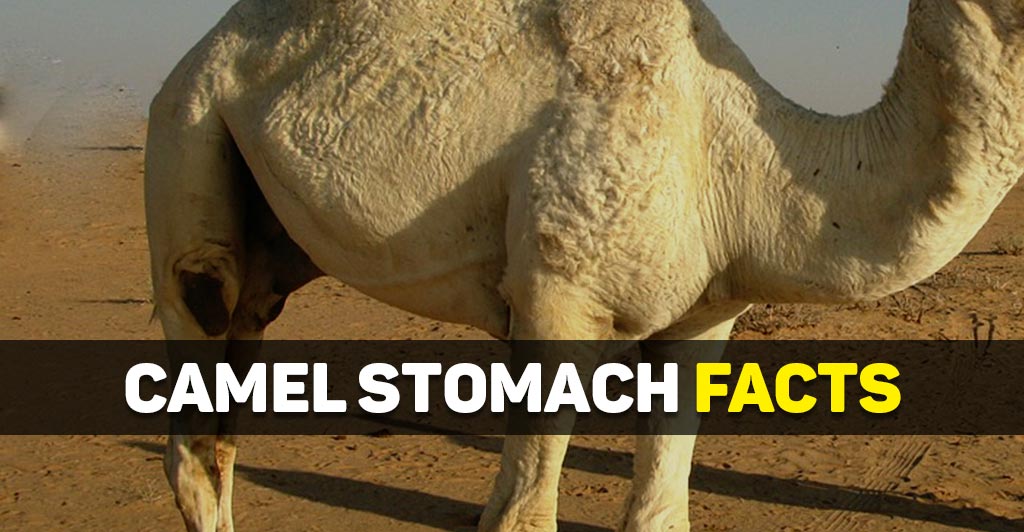Camels are herbivores that mostly eat plants and grass. Sometimes, you will find them devouring an entire cactus. Pretty badass, I’d say.
After they finish chewing the thorny plant, thanks to the help from their tough tongue and teeth, that food moves to another fascinating organ, their stomach.
The camel stomach is a multichambered structure that stores, breaks down, and digests food.
Here are 7 amazing camel stomach facts for you.
Make sure to read until the end.

Table of Contents
Camel Stomach Facts
1. Camels Are Not Ruminants With Four-Chambered Stomachs
Many classify camels as ruminants, which is wrong. Camels are considered to be pseudo-ruminants. Compared to ruminants that have a four-chambered stomach, camels have a three-chambered one. [1]
Those three stomach parts are the forestomach or rumen, reticulum, and abomasum; this is similar to the stomach morphology of llamas.
2. Camels Also Store Water In Their Stomachs
Inside their stomachs, camels have a unique water sac structure that is used to store water.
Compared to other ruminants, the camel’s first stomach, the rumen, has water cells areas. The two parts of the rumen, the dorsal and ventral ruminal sacs, contained the cranioventral, caudoventral, and caudodorsal sacs.
These 3 sacks work as a water tank storage, as camels sometimes might drink 53 gallons (200 liters) in three minutes to recover from dehydration.
They consist of primary, secondary, and partial pillars and folds. [4]
2. Camels Can Spit Contents From Their Stomach
Camels can throw up the contents of their stomach, mix it with saliva, and spit it as a projectile when feeling in distress. It is said that that slimy ball coming out of the camel’s mouth can fly up to 42 feet in distance (13 meters).
That mixture of saliva and partially digested plants is also said to have a smell bad enough to make you feel sick or nauseous.
3. In Order To Digest Tough, Dry Grass, A Camel Needs To Regurgitate That Food
Camels will grab the food with their flexible prehensile lips, chew, and then swallow it.
After a while, a camel might decide to regurgitate that semi-digested cud for further shredding so it can properly digest it.
4. Contrary To A Popular Belief, Camels Do Not Spit Their Stomach Out To Cool Themselves Down
The organ that is usually mistaken for a stomach is called “dulla” – an inflatable sack hanging from their mouth usually used to attract females or show dominance to other males during rutting season.
No camel stomach eversion is happening here.
5. Camel’s Stomach Helps Make Healthier Cheese
An enzyme called “chymosin”, found in the stomach of young camels can be used for making healthier hard cheese. [2]
Chymosin isolated in cow’s stomach, for example, breaks down important proteins in milk such as immunoglobulins, lactoferrin, and similar. On the other hand, chymosin isolated in the stomach of camel calves does not break down those proteins. That allows the cheese to keep more of its natural nutrients and stay fresh longer.
And before we finish this one, we want to draw attention to another, sadly a negative, camel stomach fact.
7. Plastic Death In Stomach
Scientists in Dubai have recently discovered more than 300 camels dead in the region with over 2000 plastic bags being extracted from their stomachs. [3]
After they swallow the bags found in the open, camel’s are unable to digest the plastic. That can cause ulcers, internal bleedings, intestinal blockages, and ultimately death.
1 in 100 camel deaths is said to occur because of this situation, and they call it a slow plastic death.
A lot more awareness of the harmful use of plastic is required and worldwide legislation to combat it. Hopefully, a day will come soon where such facts will not find their place in any article.
Final Thoughts
And there you go!
We hope that you learned something new about camels today and that you enjoyed our top 7 camel stomach facts. If you are interested in learning more about how camels eat, and how that food gets to the camel’s stomach, check this article.
Sources:
[1] Wang, Jian‐Lin, et al. “Anatomical subdivisions of the stomach of the Bactrian camel (Camelus bactrianus).” Journal of Morphology 245.2 (2000): 161-167.
[2] Culture, culturecheesemag.com
[3] Waste360, waste360.com, Informa Markets Division
[4] Allouch, Gamal. “Anatomical study of the water cells area in the dromedary camels rumen (Camelus dromedarius).” Nova J. Med. Biol. Sci 5 (2016): 1-4.